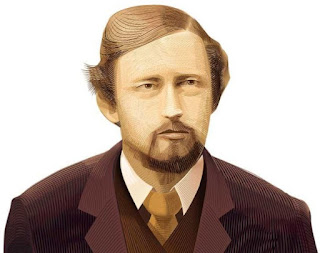Hinton's Cubes
Charles Howard Hinton was a British mathematician and writer of science fiction works titled Scientific Romances.
He was interested in higher dimensions,particularly the fourth dimension.Hinton spent years developing ingenious methods by which the average person and a growing legion of followers, not only professional mathematicians, could see four- dimensional objects.Eventually, he perfected special cubes that if one tried hard enough,could allow one to visualize hypercubes or cubes in four dimensions.Hinton even coined the official name for an unravaled hypercube, a tessaract.A hypercube can't be visualized, but one can unravel a hypercube into its lower components, three dimensional cubes.These cubes, in turn, can be arranged in a three-dimensional cross- a tessaract. It is impossible for us to visualize how to wrap up these cubes to form a hypercube. However, a higher dimensional person can "lift" each cube off our universe and then wrap up the cube to form a hypercube.So pervasive was Hinton's influence that Salvadore Dali used Hinton's tesseract in his famous painting "Christus Hypercubus", on display at the Metropolitan Museum of Art in New York, which depicts Christ being crucified on a 4D cross.
Hinton also knew of a second way to visualize higher dimensional objects by looking at the shadows they cast in lower dimensions. For example, a Flatlander(2D creature) can visualize a cube by looking at its 2D shadow. A cube looks like two squares joined together. Similarly, a hypercube's shadow cast on the third dimension becomes a cube within a cube.
In addition to visualizing unravelings of hypercubes and examining their shadows, Hinton was aware of a third way to conceptualize the fourth dimension by cross sections.For example, when Mr. Square(the Flatlander) is sent into the third dimension, his eyes can see only 2D cross sections of the third dimension.Thus he can see only circles appear,get larger,change color,and then suddenly disappear.Hinton knew that if we were hurled into the fourth dimension,we would see strange objects suddenly appear out of nowhere, get larger, change color, change shape, get smaller, and finally disappear.
In summary, Hinton's contribution may be his popularization of higher dimensional figures using three methods: by examining their shadows, their cross sections, and their unravelings.
Writer :- Nilabh Jyoti Kalita
Email id:- nilabhkalita47095@gmail.com
Sources:- Wikipedia and "Hyperspace" by Michio Kaku

